Green Bugs on Plants (Pictures) – Identification and How To Get Rid of Them
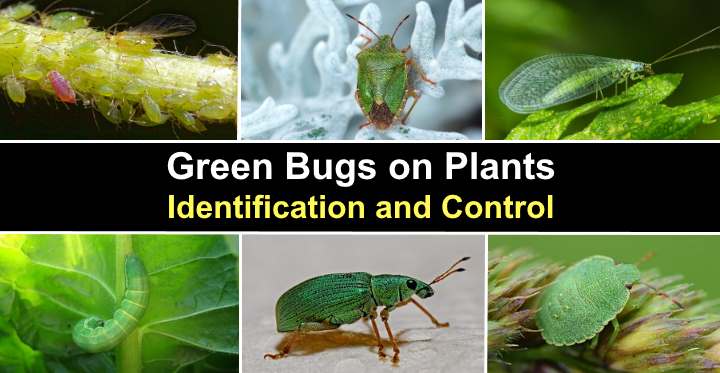
Identifying green bugs on plants is key to preventing pests from destroying your houseplants, or outdoor plants. Small green bugs such as aphids can suck plant sap from stems or leaves, causing plants to wither and die. Other bugs with green bodies like Japanese beetles, stink bugs, or green weevils can destroy plant foliage and roots. However, some green bugs like lacewings are beneficial insects that feed on harmful plant pests.
Have you noticed green bugs crawling on your houseplants? Or suppose you spot some winged green bugs swarming around flowering shrubs in your yard? In that case, this article will help you recognize the type of green pest that could potentially destroy your plants. You will also find helpful tips on getting rid of green bugs from plants.
How to Identify Green Bugs on Plants
Identify green bugs on plants by observing their habits, appearance, and plant damage. For example, do the green insects crawl or have wings and fly? What is the bug’s shape? Some destructive green bugs have a shield-like body, others are oval, and some green bugs look like leaves.
The most common green bugs on plants are aphids. Aphids are identified as tiny green oval bugs crawling under leaves. Aphids can also develop wings and can be identified as small green flying bugs. You will also notice that aphids cause stunted plant growth.
Some green bugs such as Japanese beetles have a metallic green body when they emerge from the ground and feed on leaves.
Types of Green Bugs on Plants (Overview)
Common types of green bugs on plants are aphids, green beetles, pale green weevils, and stink bugs. Aphids or greenflies can affect houseplants, greenhouse crops, and ornamental shrubs. You will usually find stink bugs, green shield bugs, beetles, and weevils crawling on plants, feeding on leaves.
Tiny Green Bugs on Plants
The tiniest green plant bugs are generally aphids. These small crawling green insects congregate under leaves. The tiny green bugs bite into foliage with their mouthparts and feed on plant sap. As the little green bugs grow and mature, they develop wings and are identified as greenflies.
How to Get Rid of Green Bugs on Plants
Eradicating green bugs from plants requires a combination of methods. First, it’s crucial to isolate the plant from others in your house. Then you can use a neem oil spray, insecticidal soap, or rubbing alcohol as a natural insecticide to kill green bugs. Additionally, sticky traps help reduce populations of flying green bugs.
Getting rid of green bugs from ornamental shrubs, flowering bushes, and vegetables is more challenging. For example, green beetles lay eggs in the ground, and the white larvae feed on roots before the green bugs appear. Also, greenflies can be a significant nuisance, and it’s best to use a garden hose to dislodge the annoying flies.
Related reading: How to get rid of grubs in the garden.
Types of Green Bugs on Plants (with Pictures and Identification)
Aphids, stink bugs, assassin bugs, and shield bugs belong to the order Hemiptera. Therefore, they are true bugs in the botanical sense. A true bug has a mouthpart used to pierce plant tissue to suck juices. However, most people refer to any kind of green plant-destroying insects as bugs.
This article refers to all types of green insects that can harm plants as green bugs.
Green Aphids / Greenfly (Aphiodiodea)
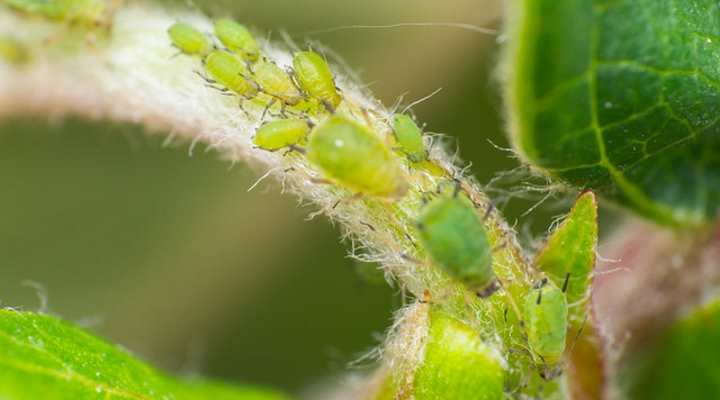
Green aphids look like tiny green insects
Green aphids are tiny green bugs with tear-shaped bodies and six legs. Aphids are so small that they are difficult to spot when immature. However, you can usually find the tiny green pests at leaf joints or underneath leaves in spring. Then, as the weather warms, aphids develop wings, and the tiny green flying bugs (named greenfly) swarm around plants.
Also called plant lice, green aphids measure 0.08” to 0.1” (2 – 3 mm) long. Typically, you only notice the green sap-sucking insects unless they are in large clusters. The greenflies are usually noticeable when you disturb the plant foliage.
In the garden, green aphids often infest roses and other ornamental shrubs. You will also find them destroying vegetable plants like cabbage, kale, lettuce, and tomatoes.
Green aphids reproduce quickly and can become a significant nuisance. If left uncontrolled, the nasty green bugs can stunt plant growth and cause leaves to wither. Although aphids rarely cause a plant to die, they can stress plants, making them susceptible to other diseases and infestations.
Another sign of green aphids on plants is an amber-colored sticky substance. This honeydew that aphids excrete can cause black sooty mold on plant foliage. In addition, you may spot an aphid infestation if there are many ants in the garden around ornamental shrubs. The ants feed on honeydew and protect aphids from predators.
Green bug identification: To identify green aphids, check the underside of leaves for tiny green insects with oval bodies. In late spring and summer, aphids are greenflies that swarm around infested plants.
How to get rid of green bugs from plants: To get rid of green aphids, use a neem oil spray once a week to kill the annoying pests. Mix 2 tsp. neem oil with 1 tsp. Castile soap in a quart (1 l) of water. Spray infested plant foliage weekly to kill the green bugs.
Related reading: How to get rid of aphids on outdoor and indoor plants.
Katydid (Tettigoniidae)
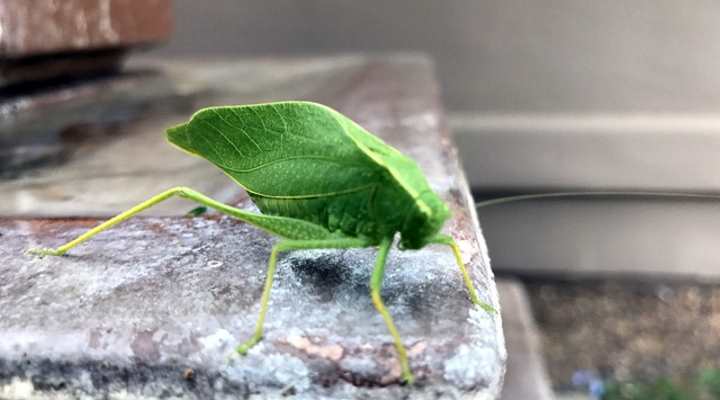
Katydids are green flying bugs that look like leaves
Katydid is a green bug that looks like a leaf. Katydid has wings and large hind legs for jumping. Also called a bush cricket, the green insect can be as tiny as 0.5” (5 mm) or as large as 5” (130 mm) long. The green leaf-like bugs live in tree foliage and fly away when disturbed.
Katydids are hard to spot because the green bugs look like leaves. The insects have distinctive wings with vein-like leaf patterns on them. Additionally, katydids have long antennae and six legs.
Katydid damage to garden shrubs and plants is rarely noticeable. This is because the green bugs live high up in trees and tall shrubs, where they feed on foliage. However, they don’t cause enough damage to harm plants or vegetables.
Green bug identification: Katydids are identified as small green bugs that look like a walking green leaf.
How to get rid of green bugs from plants: It’s rarely necessary to get rid of katydids as they don’t do much damage. However, if there are many green flying bugs, you can use light traps to attract them and release them far away from your yard.
Green June Beetle (Cotinis nitida)
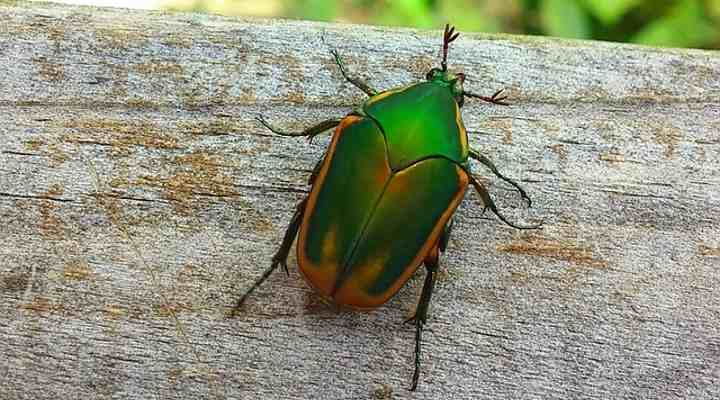
The June beetle has a green metallic body and likes to feed on fruits
The June beetle is a large green bug with a velvety greenish body and a metallic green or yellow underside. Some June beetles have dull brown bodies with green stripes. Green June beetles measure between 0.75” and 1” (19 – 25 mm) long. In June, the green beetles emerge from the ground and are active through August.
Green June beetles damage fruit by feeding on the sweet juicy flesh. The pesky green bug pierces fruits with the horn on its head and then eats the flesh. In addition, these plant-destroying bugs leave behind a foul odor and feces that ruin fruit.
Green bug identification: Green June beetles have a recognizable metallic green or brown and green body and measure up to 1” (25 mm) long and 0.5” (13 mm) wide. You will find the green beetles feeding on fruit.
Green June beetles are distinguishable from Japanese beetles by their size. Green June beetles are twice the size of Japanese beetles.
How to get rid of green bugs from plants: The best way to eradicate green beetles is by killing the white grubs in the ground. Apply Bacillus popilliae or milky spore powder to kill off the overwintering larvae. Or use beneficial nematodes, which are tiny parasitic worms that invade the bodies of the grubs. They then release bacteria that infect and kill the grubs.
Green Japanese beetle (Popillia japonica)
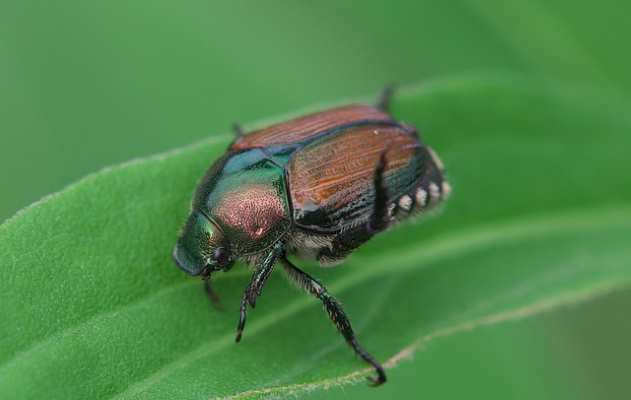
Japanese beetles have iridescent green and copper colors and white tufts on each side
The green Japanese beetle is a destructive green bug with an iridescent green and copper-colored body. The green beetles measure 0.6” (15 mm) long and 0.4” (10 mm) wide. The bugs are easily identified from other beetles due to the white tufts along their abdomen under the coppery wing covers.
Japanese beetles can do severe damage to plant foliage. You will find the leaf-destroying green bugs on maple trees, fruit trees, roses, corn, and ornamental flowering shrubs and trees. A severe Japanese beetle infestation can leave foliage skeletonized. Also, Japanese beetle larvae can cause brown patches to appear in lawns as they feed on roots.
Green bug identification: Japanese beetles have an identifiable metallic body with copper-colored wings covers and a shiny green thorax and head.
How to get rid of green bugs from plants: Killing beetle larvae with a natural substance like milky spore is the best way to control Japanese beetles. Suppose you notice a few beetles on flowers, shrubs, or vegetables. In that case, you can handpick them and drop them into soapy water to kill them instantly.
Related reading: How to kill Japanese beetles.
Green Shield Bug (Palomena prasina)
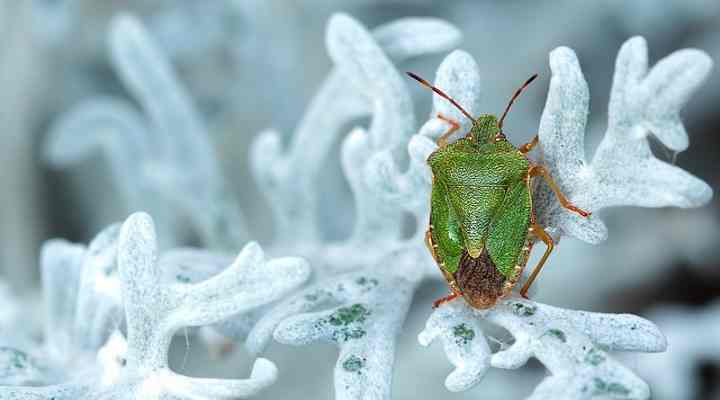
The green shield bug is a common pest that damages plants by sucking the sap from leaves
The green shield bug gets its name from its green body in the shape of a shield. The small green beetle-like insects have a recognizable dark brown patch at their base, light brown legs, and arching brown antennae. Green shield bugs are about the size of your fingernail.
Green shield bugs are true bugs in the order Hemiptera. The plant-destroying green insects bite into plant tissue, sucking the sap from tender leaves and stems. Due to their harmful activity, shield bug damage causes the plant to wilt, holes in leaves, and rotting fruit.
Green bug identification: Green shield bugs have a recognizable lime green body in the shape of a fingernail or shield about 0.5” (13 mm) long.
How to get rid of green bugs from plants: If you catch a shield bug, squash it, and the odor will alert others nearby who will play dead and drop to the ground. Then, go around your garden, pick up all the bugs you find and put them in soapy water.
It’s challenging to get rid of green shield bugs because they scurry away fast when disturbed. So the best time to handpick them from plants is in the morning before it gets warm.
Green Stink Bug (Chinavia hilaris)
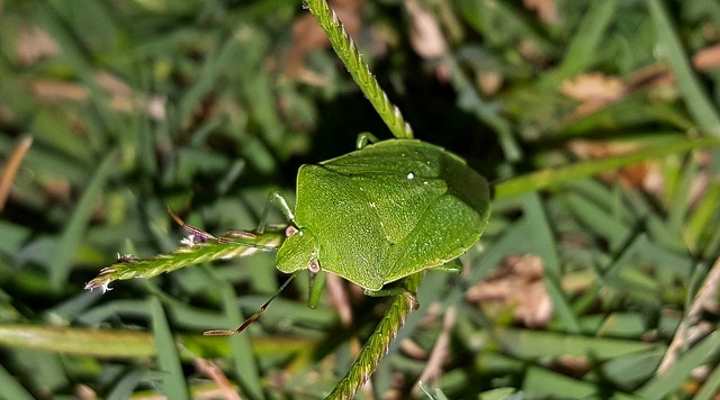
The green stink bug feeds on the juices of a wide variety of plants and releases foul-smelling liquid when disturbed
The green stink bug is a brightly colored green bug with a shield-like body, recognizable V-shaped marking on its back, and a dark green patch at its base. However, unlike the shield bug, the green stink bug has green legs and black antennae. Green stink bugs measure between 0.5” and 0.7” (13 – 18 mm).
As its name suggests, green stink bugs emit a foul odor when crushed. Green stink bugs cause plant damage by piercing plant foliage and feeding on plant sap. You will find the sap-sucking green bugs in gardens, orchards, and vegetable patches. The green bugs also feed on seeds and can destroy whole crops.
Green bug identification: Green stink bugs have a bright green, shield-shaped body in an oval form.
How to get rid of green bugs from plants: Getting rid of green stink bugs is difficult. So, it’s best to keep gardens free from debris, weeds, and overgrowth. Green stink bugs usually overwinter in these places.
Pale Green Weevil Beetle (Polydrusus impressifrons)
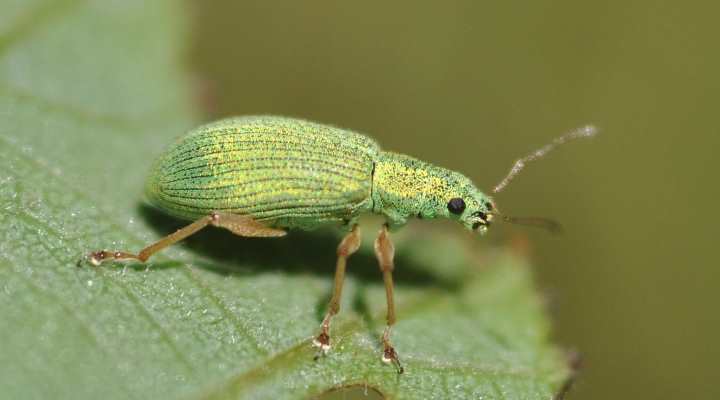
The pale green weevil beetle eats the leaves of a variety of trees
The pale green weevil has an elongated green oval body with ridges along its wing covers, brown legs, and a distinctive long snout. Also called the leaf weevil, this green bug destroys plant foliage, especially leaves on maple, willow, and poplar trees, as well as fruit trees. Pale green weevils measure 0.2” to 0.27” (5 – 7 mm) long.
Although green weevils attack leaves, they rarely do any lasting damage to mature trees and shrubs. However, the green bugs can kill saplings, and weevil larvae can damage young trees by destroying the roots.
Green bug identification: Pale green weevils have slender oval bodies with pronounced ridges along their backs.
How to get rid of green bugs from plants: Two ways to get rid of pale green weevils include using diatomaceous earth (DE) and Spinosad.
You can sprinkle DE on dry ground around plants affected by weevils. The abrasive white powder kills the beetles by damaging their exoskeleton. Spinosad is a natural bacterial substance toxic to weevils, beetles, leafminers, and ants.
Green Leafhoppers (Cicadellidae)
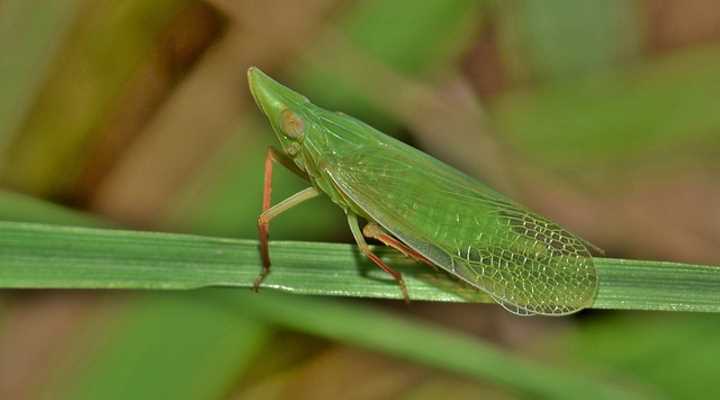
Green leafhoppers are flying bugs that are difficult to spot on plants
Green leafhoppers are wedge-shaped flying green bugs that can also run and jump. The adult green bugs grow up to 0.25” (6 mm) long. Species of green leafhoppers have transparent, glass-like wings, and others can have bright, colorful markings. Unfortunately, the green species are hard to spot because they blend in with leaves.
As a species of true bug, leafhoppers suck sap and plant juices causing leaves to have a freckled appearance. If leafhoppers are left to multiply, they can destroy a plant’s vigor and cause leaves to turn brown.
Green bug identification: Green leafhoppers have slender lime-green bodies with distinctive wedge shapes.
How to get rid of green bugs from plants: Several ways to get rid of leafhoppers include spraying neem oil, wiping leaves with insecticidal soap, and using sticky traps. Use floating row covers to protect crops and garden shrubs from leafhopper damage.
Green Ambush Bugs (Amblythyreus)
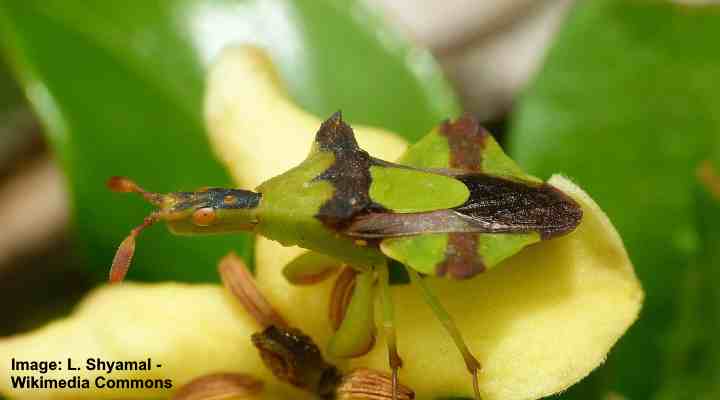
Ambush bugs suck plant juices but can be also beneficial by controlling other pests
Ambush bugs can be of various colors, including green, brown, yellow, and tan. The green bugs have recognizable hooked forelegs, distinctive jagged body contours, and wide abdomens. The strange-looking green insects measure around 0.5” (13 mm) long. A characteristic of ambush bugs is their ability to camouflage.
Ambush bugs are a type of true bug in the order Hemiptera. The green bugs use their sharp mouthpieces to puncture plant tissue and suck sap from healthy plants.
However, you shouldn’t be too quick to get rid of ambush bugs from your garden. As their name suggests, they hunt their prey and can devour harmful pests like aphids, caterpillars, and leafhoppers.
Green bug identification: Green ambush bugs have lime green bodies with distinctive brown markings. The bugs have a characteristic wing-like structure on their backs, making them appear wider than long. To help identify ambush bugs from other insects, look for the clubbed antennae and hooked forelegs.
Green Lacewing (Chrysopidae)

The green lacewing is a beneficial insect that controls other pests
Green lacewings are beneficial insects with bright green to greenish-brown bodies, translucent wings, and large compound eyes. The adult green insects grow up to 0.6” (15 mm) long and have a wingspan between 0.2” and 2.5” (6 – 65 mm). Some species of lace bugs release a vile stink when handled.
Lacewings are helpful for controlling other pests in gardens and greenhouses. The adult green flies prey on aphids, spider mites, moth and caterpillar eggs, scale insects, mealybugs, and lace bugs.
Green bug identification: Green lacewings are tiny green insects with translucent lacy wings, long antennae, and pronounced compound eyes.
Related articles:
